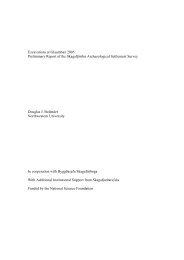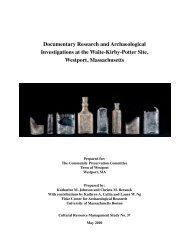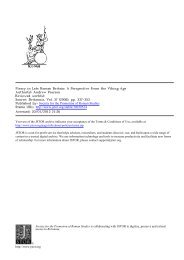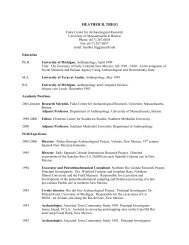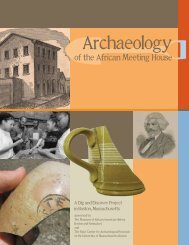Barrett, Locker and Roberts - Fiske Center
Barrett, Locker and Roberts - Fiske Center
Barrett, Locker and Roberts - Fiske Center
You also want an ePaper? Increase the reach of your titles
YUMPU automatically turns print PDFs into web optimized ePapers that Google loves.
James H. <strong>Barrett</strong>, Alison M. <strong>Locker</strong> & Callum M. <strong>Roberts</strong><br />
first millennium. The fictional fisherman oiAilfric's Colloquy (c. 987-1002) claimed '^I can't<br />
catch as many as I can seir {Swanton 1975:1 10) <strong>and</strong> the laws of/Ethelred {code IV, c. 991-<br />
1002) set out tolls in London for boats containing fish (<strong>Roberts</strong>on 1 925:73).<br />
Unfortunately, despite the likelihood that the 'fish event horizon' recognised here was<br />
partly associated with pan-European trade, it is not yet possible to differentiate local fishing<br />
<strong>and</strong> long-distance imports. The suggestion that some cod at eleventh century English sites<br />
may represent Norwegian stockfish, <strong>and</strong> that some herring could have come from the Baltic<br />
region, must remain a hypothesis. It is not until the thirteenth <strong>and</strong> fourteenth centuries that<br />
species such as ling <strong>and</strong> saithe, previously common in Norwegian assemblages, also appear in<br />
Engl<strong>and</strong> in measurable numbers (Figure 3c). This may indicate that only regional trade<br />
blossomed in the eleventh/twelfth centuries, to be supplemented by long-distance trade in<br />
the thirteenth/fourteenth centuries. We think it more likely, however, that additional species<br />
such as ling <strong>and</strong> saithe were simply added to the repertoire ol^ both regional <strong>and</strong> long-range<br />
trade once cod could no longer satisfy dem<strong>and</strong>. This latter interpretation is supported by the<br />
observation that other species (such as hake) that were produced by English rather than<br />
Sc<strong>and</strong>inavian fisheries also became more common in the thirteenth to fourteenth centuries<br />
(Figure 3c; cf Kowaleski 2000).<br />
In sum, regional, <strong>and</strong> probably long-distance, fish trade began on a significant scale around<br />
the end ol" the first millennium. It presumably developed trom the more modest transport of<br />
herring to inl<strong>and</strong> sites such as York that can be observed from the seventh to tenth centuries.<br />
This earlier pattern probably also represents trade in a market sense, but could alternatively<br />
be explained by more socially embedded provisioning arrangements sometimes referred to as<br />
indirect subsistence (Hoffmann 1996: 636; O'Connor 2001). It is in these terms that one<br />
can underst<strong>and</strong> early records ot satellite fisheries, such as one on the North Devon coast<br />
granted to the inl<strong>and</strong> monastery of Glastonbury by King Etbelwulf in the mid ninth century<br />
(Fox 2001:47). Prior to r. AD 1000 much professional fishing may have been done tor elite<br />
patrons rather than public sale (cf. Hoffmann 1996).<br />
Centuries AD<br />
7lh-i(lh 'Jih-IDih Ilih-IJih<br />
Centuries AD<br />
igure 7. Boxptols showing ihc pencnuiges of (a) herring inid (hj cod in English urban (including pi oto-urbiw 'wic') uiid rural<br />
f I dements from AD 600 to 1600 (based on NISPj.<br />
627



